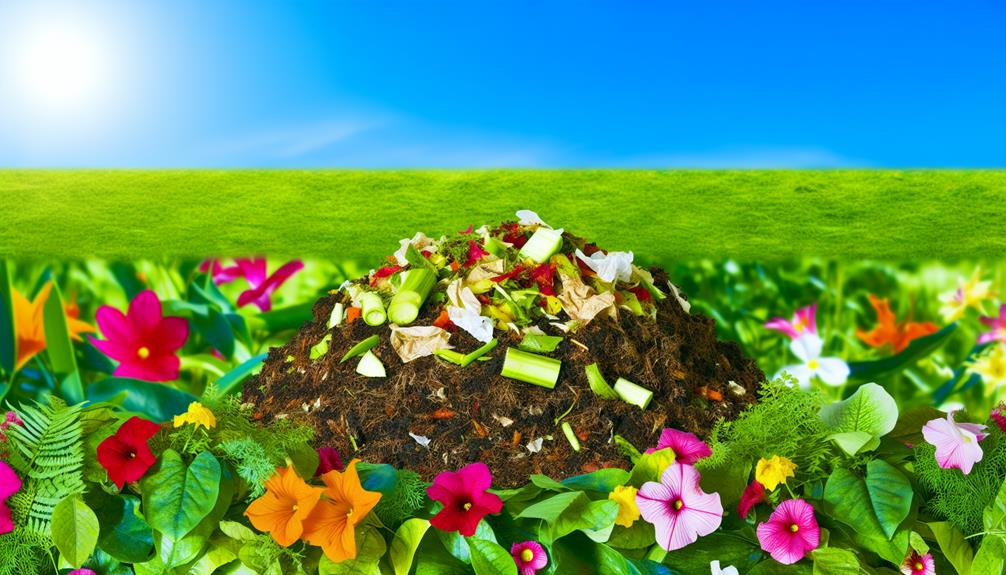

Yes, you can compost cheesecloth if it’s made of 100% natural cotton fibers and free from synthetic materials and contaminants. Before composting, cut it into smaller pieces to speed up decomposition. Make sure your compost pile has a balanced mix of green (nitrogen-rich) and brown (carbon-rich) materials.
Turning the pile regularly, maintaining proper moisture levels, and guaranteeing good aeration will enhance the composting process. Composting cheesecloth reduces landfill waste, enriches soil, and supports sustainability. For further insights on effective composting techniques and other compostable items, continue exploring.
You’ll want to check if your cheesecloth is made from natural fibers like cotton, which are compostable.
Keep in mind that the decomposition time frame can vary depending on the thickness and weave of the material.
Because cheesecloth is typically made from natural fibers like cotton, it can be a great addition to your compost pile. Cotton is a biodegradable material, sourced from plants, which makes it an eco-friendly option for composting. When considering cheesecloth’s compostability, it’s vital to recognize its fiber durability. Cotton fibers break down relatively easily compared to synthetic materials, making them ideal for composting.
First, make sure that your cheesecloth is 100% cotton and not blended with synthetic fibers. Synthetic fibers won’t decompose and can contaminate your compost. You can usually find this information on the packaging or by contacting the manufacturer. Material sourcing is also essential; organic cotton is preferable as it’s free from harmful chemicals that might affect your compost.
To compost cheesecloth effectively, cut it into smaller pieces. This increases the surface area and speeds up the decomposition process. Mixing the shredded cheesecloth with other compost materials like vegetable scraps and yard waste helps create a balanced compost pile. Regularly turning your compost and maintaining proper moisture levels will also aid in the breakdown of the cotton fibers.
How long does it take for cheesecloth to decompose in a compost pile? Generally, it can take anywhere from a few months to a year, depending on several breakdown factors. Cheesecloth is made from natural fibers like cotton, which are biodegradable, but the exact decomposition time varies based on the conditions in your compost pile.
To understand the decomposition stages, you’ll need to take into account the size and condition of the cheesecloth. Shredding the cheesecloth into smaller pieces will speed up the process. Moisture levels, temperature, and aeration in your compost pile also play important roles. A well-maintained compost pile with ideal moisture and regular turning will accelerate the breakdown.
Additionally, the presence of microorganisms is essential. These tiny decomposers thrive in a balanced compost environment and help break down the cheesecloth more efficiently. Make sure your compost pile has a mix of green and brown materials to support these microbial activities.
Composting cheesecloth offers an eco-friendly way to minimize waste and enrich your soil. By incorporating cheesecloth into your compost pile, you’re actively participating in waste reduction and lowering your carbon footprint.
The natural fibers in cheesecloth break down efficiently, adding valuable organic material to your compost.
When you choose to compost cheesecloth, you make a conscious decision to support sustainable practices. This small action contributes to a larger movement toward environmental responsibility. Instead of sending cheesecloth to the landfill, where it would contribute to waste and greenhouse gas emissions, you’re repurposing it in a beneficial way.
To make sure you get the best results, cut the cheesecloth into smaller pieces before adding it to your compost. This accelerates decomposition and integrates it more evenly into the mix.
Remember to balance your compost pile with green (nitrogen-rich) and brown (carbon-rich) materials. Cheesecloth fits into the brown category, so balance it with kitchen scraps or grass clippings.
Also Read: Can You Compost Blood?
Switching to compostable cheesecloth greatly reduces your environmental footprint by minimizing waste and promoting sustainable practices. When you choose compostable materials, you help decrease landfill waste, which is a significant step toward a greener future.
Traditional cheesecloth often ends up in landfills, contributing to the growing problem of waste management. By opting for compostable alternatives, you’re not only reducing the volume of waste but also ensuring that the materials decompose naturally, returning valuable nutrients to the soil.

Recycling alternatives, while beneficial, sometimes fall short because not all cheesecloth materials are recyclable. Composting offers a more complete solution by breaking down organic fibers entirely, leaving no harmful residues. By integrating compostable cheesecloth into your routine, you join a community of environmentally conscious individuals committed to making a positive impact.
Remember to look for cheesecloth made from natural fibers like cotton or hemp, as these are more likely to be compostable. Avoid synthetic blends, which can contaminate your compost heap. By making this simple switch, you contribute to a larger movement, fostering a sense of belonging within the eco-friendly community. Together, small changes can lead to significant environmental benefits.
To prepare cheesecloth for composting, you first need to make sure it’s free of any synthetic materials or contaminants. Begin by checking the label; pure cotton cheesecloth is ideal. Remove any stains or food residues using appropriate cleaning methods. Soak the cheesecloth in a mixture of warm water and mild detergent, then rinse thoroughly. Avoid using harsh chemicals that might impact compost quality.
Next, consider reuse options before composting. Cheesecloth can often be repurposed for various household tasks. For instance, you can use it in the kitchen for straining, wrapping herbs, or even as a cleaning rag. If the cheesecloth is still in decent condition, reusing it extends its life and reduces waste.
Once you’ve confirmed the cheesecloth is clean and free from contaminants, cut it into smaller pieces. This step helps speed up the composting process, allowing microorganisms to break it down more efficiently. Remember, the smaller the pieces, the quicker they’ll decompose.
Also Read: Can You Compost Basil?
To get the most out of composting, you need to know which materials are suitable and how to properly manage your compost. Start by including a balanced mix of green and brown materials, like vegetable scraps and dried leaves.

Turn your compost regularly to guarantee even decomposition and maintain the right moisture levels.
Among the most suitable materials for composting, organic kitchen scraps and yard waste stand out as excellent choices. These materials break down efficiently and provide essential nutrients to your compost.
Let’s explore some top items to include:
When adding these materials, make sure they’re free from chemicals or synthetic substances. Stick to organic waste to maintain the purity of your compost.
Remember to balance green (nitrogen-rich) and brown (carbon-rich) materials to facilitate effective decomposition. Avoid adding meat, dairy, or oily foods, as they can attract pests and create unpleasant odors.
When composting, it’s important to maintain a balanced mix of green and brown materials to guarantee efficient decomposition. Green materials include kitchen scraps and grass clippings, providing nitrogen. Brown materials, like dry leaves and cardboard, supply carbon. Both are essential for a healthy compost pile.
To optimize your compost, focus on aeration techniques. Regularly turn your compost pile with a pitchfork or compost aerator to introduce oxygen. This speeds up the decomposition process and prevents unpleasant odors. Aim to turn your pile every 7-10 days for the best results.
Moisture control is also critical. Your compost should be as damp as a wrung-out sponge. Too much water can lead to a soggy, anaerobic pile, while too little will slow decomposition. If the pile is too dry, add water or green materials. Conversely, if it’s too wet, mix in more brown materials to absorb the excess moisture.
Also Read: Can You Compost Apricot Pit?
By composting cheesecloth, you can reduce waste while enriching your garden soil with valuable nutrients. When you add cheesecloth to your compost pile, you’re not just getting rid of an item that would otherwise end up in the landfill. You’re also contributing to soil enrichment, making your garden thrive.
Here are three key benefits of composting cheesecloth:
You’re wondering if dyed cheesecloth can be composted safely. It’s important to take into account the environmental impact and potential dye toxicity. If the dye’s non-toxic and eco-friendly, it’s usually safe to compost.
You’re wondering about the decomposition rate of cheesecloth in compost. Generally, it takes a few months for organic breakdown, but factors like material type and compost conditions can influence the speed. It’s all about patience and community effort!
Yes, you can reuse cheesecloth before composting. Just follow simple cleaning methods, like hand washing with mild soap, and then air dry. For storage tips, fold and store it in a dry, breathable container.
You’re considering alternatives to cheesecloth for composting. Muslin fabric is a great eco-friendly option, and nylon alternatives can work too, though they’re less sustainable. Choose what fits your green lifestyle, and you’ll feel connected to the community.
Yes, cheesecloth can attract pests to your compost pile if it contains food residue. To guarantee effective pest prevention and compost hygiene, make sure you clean the cheesecloth thoroughly or consider using alternatives to maintain a healthy compost community.
To sum up, you can compost cheesecloth if it’s made from natural fibers like cotton or linen. Make sure it’s clean and cut into smaller pieces to speed up decomposition.
By composting cheesecloth, you’re reducing landfill waste and enriching your soil with valuable nutrients. Remember to maintain a balanced compost pile with a mix of green and brown materials.
Following these tips will help you compost effectively and contribute positively to the environment.
